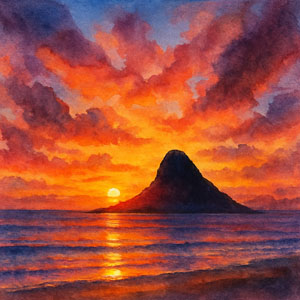~ John Donne
 A symbolic part of Hawaiian history and spirituality, the small islet off Oʻahu’s northeastern shore is affectionately known as Chinaman’s Hat for its cone-like shape. To early Hawaiians, the island was Mokolii—“fin of the lizard.”
A symbolic part of Hawaiian history and spirituality, the small islet off Oʻahu’s northeastern shore is affectionately known as Chinaman’s Hat for its cone-like shape. To early Hawaiians, the island was Mokolii—“fin of the lizard.”
Legend says the jagged islet is the last remains of a mighty moʻo (lizard/dragon) defeated by Hiʻiaka, sister of the volcano goddess Pele, and hurled into the sea. Sacred stories linger in the mist and wind.
Considered a puʻuhonua, or place of refuge, Mokolii was revered by passing canoes—sails respectfully lowered. Aliʻi (royalty) brought their children here to study the arts of leadership and survival.
Today, if the tide is low and you wear sturdy footwear, you can wade or swim to the island’s tiny beach and quiet bird sanctuary. Time slows. Mana whispers.
Mokolii rests just off Kualoa Regional Park, a 150-acre peninsula lined with palms and wiliwili trees, glowing red in winter. The view of the Koʻolau range and Kāneʻohe Bay is breathtaking—moʻomeheu and nature in harmony.
As John Muir once wrote, “The grand show is eternal… Eternal sunrise, eternal dawn and gloaming, on sea and continents and islands, each in its turn, as the round earth rolls.”
 We need each other and are a part of each other.🌸💫
We need each other and are a part of each other.🌸💫
